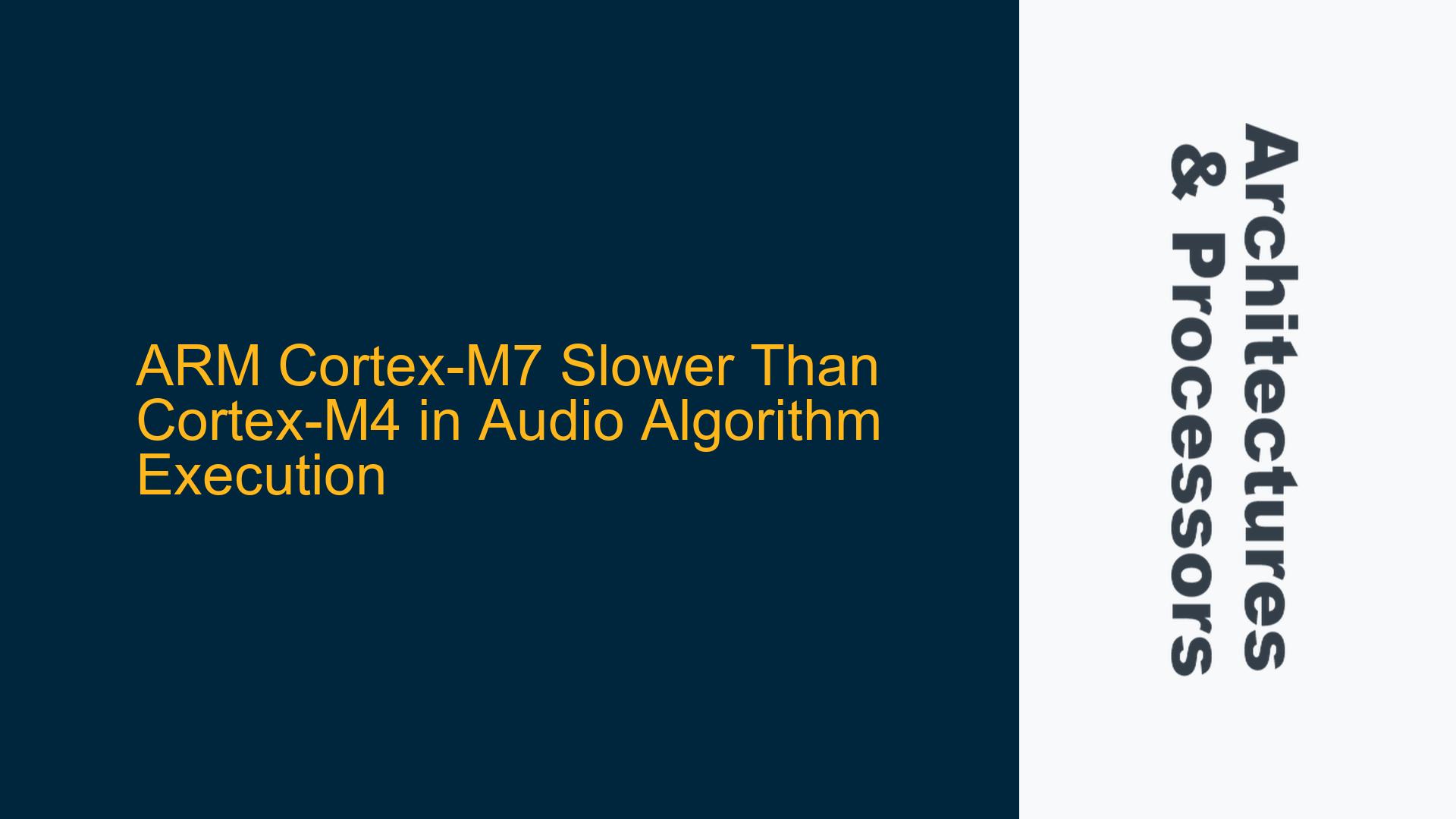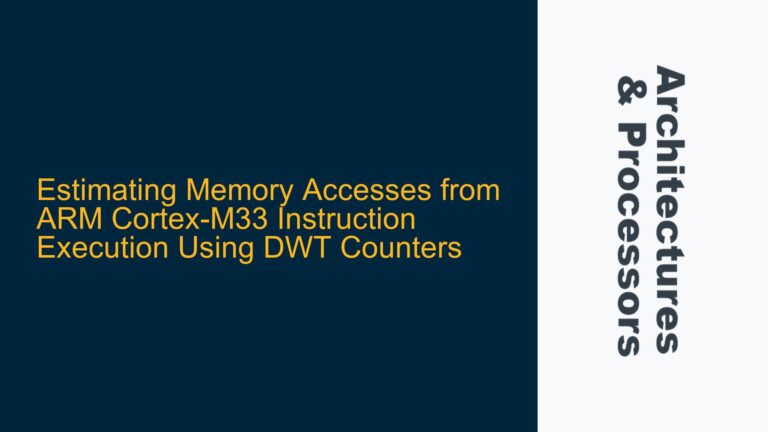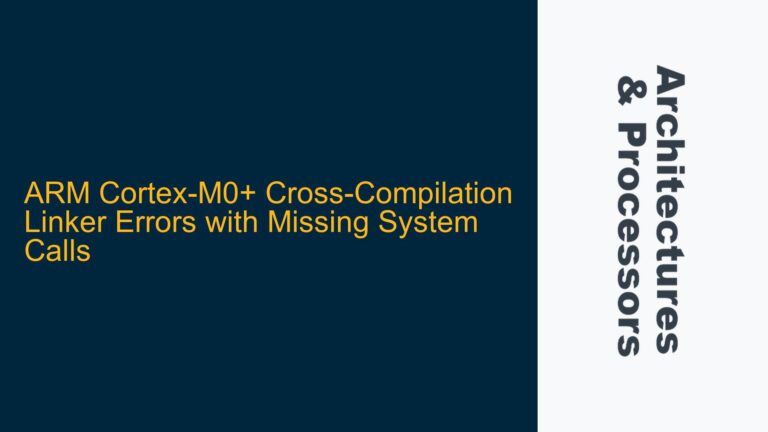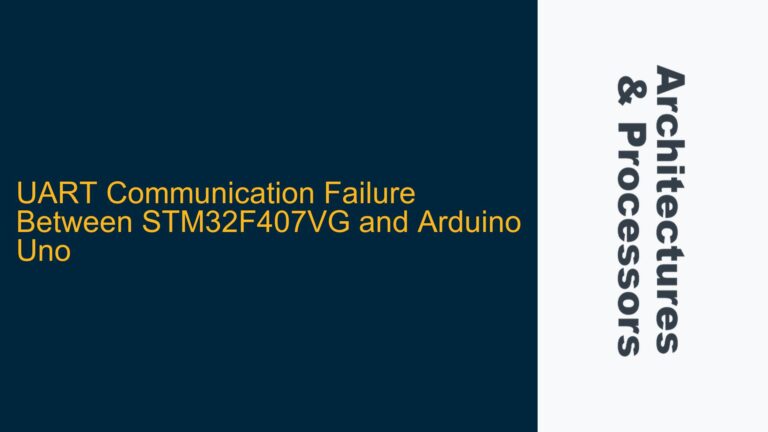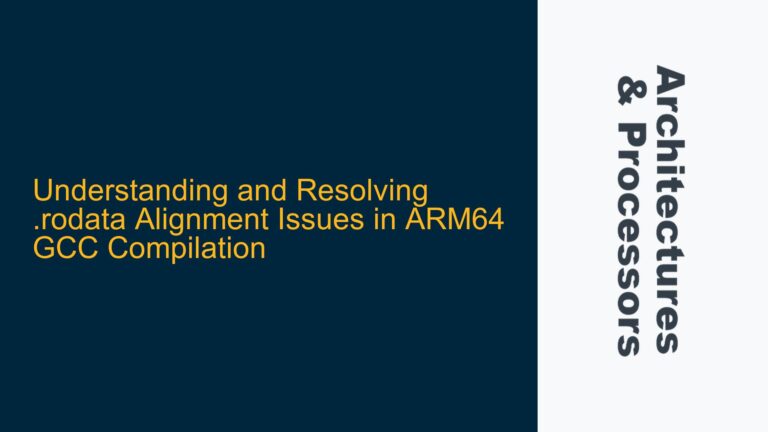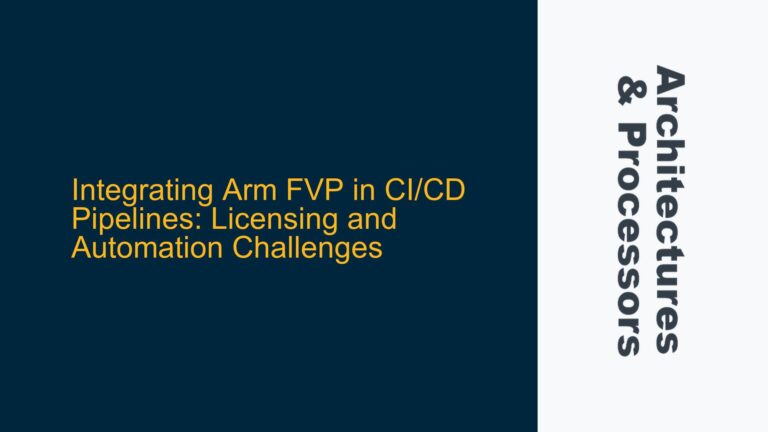ARM Cortex-M7 Cache and Memory Configuration Impact on Performance
The ARM Cortex-M7 is a high-performance processor designed for applications requiring significant computational power, such as digital signal processing (DSP) and real-time audio processing. However, in this case, the Cortex-M7 running at 300 MHz is underperforming compared to a Cortex-M4 running at 168 MHz when executing an audio reverberation algorithm. The primary issue lies in the improper configuration of the Cortex-M7’s cache and memory subsystems, which are critical for achieving optimal performance.
The Cortex-M7 features both Instruction Cache (I-Cache) and Data Cache (D-Cache), which are essential for reducing memory access latency. The I-Cache accelerates instruction fetch operations, while the D-Cache speeds up data access. However, these caches must be properly enabled and configured to realize their benefits. In this scenario, the firmware is running from internal flash memory, which has inherent latency due to wait states. Without proper cache utilization, the processor spends significant cycles waiting for instructions and data, negating the performance advantages of the higher clock speed.
Additionally, the Cortex-M7’s Tightly Coupled Memory (TCM) can be used to store critical data and code segments, ensuring low-latency access. TCM is particularly useful for real-time applications where deterministic access times are required. However, the firmware in question does not leverage TCM effectively, leading to suboptimal performance.
The DMA buffer is correctly marked as non-cacheable to avoid coherency issues, but other data regions, such as constants and literal data, are not placed in D-TCM or marked as non-cacheable. This results in unnecessary cache thrashing and reduced performance. Furthermore, the flash memory wait states are set to 5, which is appropriate for 300 MHz operation, but the firmware does not fully utilize the available cache mechanisms to mitigate the impact of these wait states.
Flash Wait States, Cache Thrashing, and DMA Coherency Overhead
The Cortex-M7’s performance is heavily influenced by the configuration of flash memory wait states and the management of cache coherency during DMA operations. Flash memory access times are significantly slower than the processor’s clock speed, necessitating the use of wait states to ensure reliable operation. At 300 MHz, the flash memory requires 5 wait states, which introduces latency in instruction and data fetch operations. While this is necessary for stable operation, the impact of these wait states can be mitigated through proper cache utilization.
Cache thrashing occurs when the cache is frequently invalidated or flushed, leading to repeated cache misses and increased memory access latency. In this case, the firmware does not effectively manage cache coherency for data regions shared between the processor and DMA controller. Although the DMA buffer is marked as non-cacheable, other data regions, such as constants and literal data, are not placed in D-TCM or marked as non-cacheable. This results in unnecessary cache invalidations and reduced performance.
DMA coherency overhead is another critical factor affecting performance. The Cortex-M7’s DMA controller operates independently of the processor’s cache, requiring explicit cache maintenance operations to ensure data coherency. Without proper cache management, the processor may access stale data from the cache, leading to incorrect results and increased processing time. The firmware does not implement cache maintenance routines to ensure coherency between the processor and DMA controller, further exacerbating the performance issues.
The combination of flash wait states, cache thrashing, and DMA coherency overhead significantly impacts the Cortex-M7’s performance, resulting in slower execution times compared to the Cortex-M4. Addressing these issues requires a comprehensive approach to cache and memory configuration, including the use of TCM, proper cache maintenance routines, and optimization of flash memory access.
Enabling Caches, Leveraging TCM, and Optimizing Flash Access
To resolve the performance issues on the Cortex-M7, a series of steps must be taken to enable caches, leverage TCM, and optimize flash memory access. These steps are essential for achieving the full potential of the Cortex-M7’s high-performance architecture.
First, both the I-Cache and D-Cache must be enabled to reduce memory access latency. The I-Cache accelerates instruction fetch operations, while the D-Cache speeds up data access. Enabling these caches can significantly improve performance, especially when running code from flash memory with wait states. In this case, enabling the caches provided an 8-10% performance improvement, but further optimizations are required to fully realize the benefits of caching.
Second, critical data and code segments should be placed in TCM to ensure low-latency access. TCM is particularly useful for real-time applications where deterministic access times are required. By moving important routines and constant data from flash to TCM, the firmware can reduce the impact of flash wait states and improve overall performance. In this scenario, moving critical routines and data to TCM provided an additional 15% performance improvement.
Third, flash memory access must be optimized to minimize the impact of wait states. The flash memory wait states are set to 5, which is appropriate for 300 MHz operation. However, the firmware can further optimize flash access by using prefetching and branch prediction mechanisms. These mechanisms can reduce the effective latency of flash memory access, improving overall performance.
Finally, cache maintenance routines must be implemented to ensure coherency between the processor and DMA controller. The DMA buffer is correctly marked as non-cacheable, but other data regions, such as constants and literal data, must also be managed to avoid cache thrashing. By using cache maintenance routines, the firmware can ensure that the processor accesses the most up-to-date data, reducing processing time and improving performance.
In conclusion, the Cortex-M7’s performance issues can be resolved through proper cache and memory configuration, including enabling caches, leveraging TCM, optimizing flash access, and implementing cache maintenance routines. These steps are essential for achieving the full potential of the Cortex-M7’s high-performance architecture and ensuring that it outperforms the Cortex-M4 in real-time audio processing applications.
Detailed Analysis and Recommendations
Cache Configuration and Optimization
The Cortex-M7’s cache subsystem is a critical component for achieving high performance. The I-Cache and D-Cache must be enabled and properly configured to reduce memory access latency. The I-Cache accelerates instruction fetch operations, while the D-Cache speeds up data access. In this case, enabling the caches provided an 8-10% performance improvement, but further optimizations are required to fully realize the benefits of caching.
To optimize cache performance, the firmware should use cache maintenance routines to ensure coherency between the processor and DMA controller. The DMA buffer is correctly marked as non-cacheable, but other data regions, such as constants and literal data, must also be managed to avoid cache thrashing. By using cache maintenance routines, the firmware can ensure that the processor accesses the most up-to-date data, reducing processing time and improving performance.
Leveraging Tightly Coupled Memory (TCM)
TCM is a low-latency memory resource that can be used to store critical data and code segments. By placing important routines and constant data in TCM, the firmware can reduce the impact of flash wait states and improve overall performance. In this scenario, moving critical routines and data to TCM provided an additional 15% performance improvement.
To leverage TCM effectively, the firmware should identify the most frequently accessed data and code segments and place them in TCM. This includes the reverberation algorithm, constant data, and any other critical routines. By reducing the latency of these operations, the firmware can significantly improve performance.
Optimizing Flash Memory Access
Flash memory access is a major bottleneck for the Cortex-M7, especially at high clock speeds. The flash memory wait states are set to 5, which is appropriate for 300 MHz operation. However, the firmware can further optimize flash access by using prefetching and branch prediction mechanisms.
Prefetching allows the processor to fetch instructions and data before they are needed, reducing the effective latency of flash memory access. Branch prediction mechanisms can reduce the impact of conditional branches, improving the efficiency of instruction fetch operations. By optimizing flash memory access, the firmware can reduce the impact of wait states and improve overall performance.
Compiler and Optimization Settings
The choice of compiler and optimization settings can also impact the performance of the Cortex-M7. In this case, the firmware is compiled with the "O3" optimization level, which provides a good balance between performance and code size. However, further optimizations can be achieved by using link-time optimization (LTO) and other advanced compiler features.
LTO allows the compiler to optimize the entire program at link time, rather than on a per-file basis. This can result in significant performance improvements, especially for complex algorithms. Additionally, the firmware should experiment with different optimization levels, such as "Ofast" and "Os," to determine the best settings for the specific application.
Conclusion
The Cortex-M7’s performance issues can be resolved through proper cache and memory configuration, including enabling caches, leveraging TCM, optimizing flash access, and implementing cache maintenance routines. These steps are essential for achieving the full potential of the Cortex-M7’s high-performance architecture and ensuring that it outperforms the Cortex-M4 in real-time audio processing applications. By following these recommendations, the firmware can achieve significant performance improvements and meet the demands of the audio processing algorithm.
